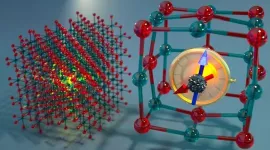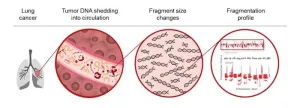(Press-News.org) Calcium oxide is a cheap, chalky chemical compound commonly used in the manufacturing of cement, plaster, paper, and steel. But the material may soon have a more high-tech application.
UChicago Pritzker School of Molecular Engineering researchers and their collaborator in Sweden have used theoretical and computational approaches to discover how tiny, lone atoms of bismuth embedded within solid calcium oxide can act as qubits — the building blocks of quantum computers and quantum communication devices. These qubits are described today in Nature Communications.
“This system has even better properties than we expected,” said Giulia Galli, Liew Family Professor at Pritzker Molecular Engineering and Chemistry and senior author of the new work. “It has an incredibly low level of noise, can hold information for a long time, and is not made with a fancy, expensive material.”
A quantum bit, or qubit, is the basic unit of information that encodes data in quantum computing. Today, researchers have developed many different types of qubits, which are often composed of tiny point defects within semiconducting materials. Some of the properties of these defects can be used to store pieces of information. However, many existing qubits are incredibly fragile; electronic or magnetic “noise” in their surroundings can change their properties, erasing any information that was encoded within them.
In 2022, a collaboration between scientists in Japan and the groups of David Awschalom and Galli simulated the properties of more than 12,000 materials to discover new potential solids that could contain promising defects acting as qubits. That work turned up calcium oxide as one of a number of materials with the potential to contain qubits that encoded information with very low levels of noise for an especially long period of time.
“Our previous work told us that if you find the right defects to put within its structure, calcium oxide would be a perfect medium for storing quantum information,” said Nikita Onizhuk, a postdoctoral fellow in the Galli group and one of the authors of the paper. “So our new goal was to find the ideal defect.”
In the new paper, Galli and her colleagues used a series of computational methods that were established over recent years to screen more than 9,000 different defects within calcium oxide for their potential as qubits. The results pointed toward one type of defect — in which an antimony, bismuth or iodine atom is embedded within the usual structure of calcium and oxygen that make up calcium oxide.
“We never could have guessed that these exact defects would be so promising,” said Joel Davidsson of Linköping University, the first author of the paper and the main developer of the high-throughput approach used to discover novel spin defects. “The only way to do this was with thorough and unbiased screen procedures.”
Galli’s team then showed through their modeling approaches that the bismuth defect within calcium oxide can theoretically encode data with little noise and for relatively long periods of time (multiple seconds compared to the milliseconds of coherence shown by many qubits). It also has the potential to mesh well with telecommunications devices because of the material’s refractive index and its ability to emit photons of light.
Galli and collaborators are now working with experimental groups who can build the calcium-oxide-based materials and test whether the predictions hold true.
“We’re at the very early stages, but from a fundamental science point of view, we think this material is very promising,” Galli said.
Citation: “Discovery of Atomic Clock-Like Spin Defects in Simple Oxides from First Principles,” Davidsson et al, Nature Communications, June 6, 2024. DOI: 10.1038/s41467-024-49057-8
Funding: This work was supported by the Swedish e-science Research Centre (SeRC), the Knut and Alice Wallenberg Foundation, the Swedish Research Council, a Google PhD Fellowship, and the Air Force Office of Scientific Research.
END
Calcium oxide’s quantum secret: nearly noiseless qubits
2024-06-06
ELSE PRESS RELEASES FROM THIS DATE:
Innovative combination therapy shows promise for bladder cancer patients unresponsive to standard treatment
2024-06-06
TAMPA, Fla. (June 6, 2024) — In a groundbreaking advance that could revolutionize bladder cancer treatment, a novel combination of cretostimogene grenadenorepvec and pembrolizumab has shown remarkable efficacy in patients with Bacillus Calmette-Guérin (BCG)-unresponsive non-muscle invasive bladder cancer. Results from the phase 2 CORE-001 trial, published today in Nature Medicine, reveal a significant improvement in complete response rates and long-term disease control, offering new hope for patients with this challenging condition who face limited treatment options.
The trial included patients with BCG-unresponsive carcinoma in situ of the bladder, a condition that is notoriously ...
SFU Physics collaboration pushes an information engine to its limits
2024-06-06
The molecules that make up the matter around us are in constant motion. What if we could harness that energy and put it to use?
Over 150 years ago Maxwell theorized that if molecules’ motion could be measured accurately, this information could be used to power an engine. Until recently this was a thought experiment, but technological breakthroughs have made it possible to build working information engines in the lab.
With funding from the Foundational Questions Institute, SFU Physics professors John Bechhoefer and David Sivak teamed up to build an information engine and test its limits. Their work has greatly advanced ...
Artificial intelligence blood test provides a reliable way to identify lung cancer
2024-06-06
Using artificial intelligence technology to identify patterns of DNA fragments associated with lung cancer, researchers from the Johns Hopkins Kimmel Cancer Center and other institutions have developed and validated a liquid biopsy that may help identify lung cancer earlier.
In a prospective study published June 3 in Cancer Discovery, the team demonstrated that artificial intelligence technology could identify people more likely to have lung cancer based on DNA fragment patterns in the blood. The study enrolled about 1,000 participants with and without cancer who met the criteria for traditional lung ...
The ethical matrix: it's not just smart; it's the smart thing to do
2024-06-06
Artificial Intelligence (AI) is the talk of the town, but far too often expediency has been the driver, not responsible innovation. The NYC Media Lab (NYCML) at NYU Tandon School of Engineering and Bertelsmann launched their 4th challenge this month, this time aimed at mentoring teams with projects that use AI to responsibly advance their fields.
The 2024 collaboration, The Ethical Matrix Challenge: Forging New AI Frontiers in Media, Communications, Education, and Healthcare, focuses on ethical AI and its power to have a real-world influence. The four selected teams have projects that can responsibly revolutionize the way ...
Study: Young athletes at risk for elevated blood pressure rates, future cardiovascular complications
2024-06-06
A substantial portion of young athletes are at risk of hypertension, according to a study presented at the American College of Cardiology’s Care of the Athletic Heart conference, taking place on June 6-8 in Washington.
High blood pressure, also known as hypertension, occurs in 47% of adults in the U.S., according to CardioSmart.org. Over time, hypertension weakens the heart, blood vessels and kidneys, paving the way for potential stroke or heart attack. Often referred to as the “silent killer,” high blood pressure is a leading risk factor for heart disease and early death.
The 2017 ACC/American Heart Association Guideline for the Prevention, ...
Mpox continues to circulate at low numbers among gay and bisexual men who have sex with men
2024-06-06
While mpox cases have sharply declined since the 2022 global outbreak, they continue to occur in the U.S. among gay and bisexual men who have sex with men (GBMSM), according to a UCLA-led study from EMERGEncy ID NET, a multisite surveillance network funded by the Centers for Disease Control and Prevention (CDC).
Though no cases were found in women, children or the unhoused, vigilance and vaccination remain important, the researchers write.
The findings will be published June 6 in the CDC’s Morbidity and Mortality Weekly Report.
Mpox, formerly known as monkeypox, ...
How the cell cycle orchestra plays an unexpected new tune
2024-06-06
How the Cell Cycle Orchestra Plays an Unexpected New Tune
UCSF scientists discover that multiciliated cells adapt the well-known process of cell division to make hundreds of cilia.
The awe-inspiring process of cell division can turn a fertilized egg into a baby – or a cancerous cell into a malignant tumor. With so much at stake, nature keeps it tightly controlled in a process called the cell cycle that scientists thought they thoroughly understood.
But now it turns out there was more to know. Scientists ...
Exotic black holes could be a byproduct of dark matter
2024-06-06
For every kilogram of matter that we can see — from the computer on your desk to distant stars and galaxies — there are 5 kilograms of invisible matter that suffuse our surroundings. This “dark matter” is a mysterious entity that evades all forms of direct observation yet makes its presence felt through its invisible pull on visible objects.
Fifty years ago, physicist Stephen Hawking offered one idea for what dark matter might be: a population of black holes, which might have formed very soon after the Big Bang. Such “primordial” black holes would not have been the goliaths that we detect today, but ...
El Centro Regional Medical Center provides financial and operational updates
2024-06-06
El Centro Regional Medical Center (ECRMC), an affiliate of UC San Diego Health, today announced several financial and operational updates, demonstrating significant progress toward stabilizing and strengthening a critical health services asset in the Imperial Valley.
“Our goal is simple — to ensure that the people of El Centro and the broader Imperial Valley have long-term access to health care services,” said Pablo Velez, RN, PhD, chief executive officer, ECRMC. “Over the last year, the amazing team of dedicated physicians and staff at ECRMC have worked tirelessly in partnership with UC San Diego ...
ESMO Gynaecological Cancers Congress 2024: Event Announcement
2024-06-06
Lugano, Switzerland, 6 June 2024 – The ESMO Gynaecological Cancers Congress 2024 will be held in Florence, Italy, between 20-22 June, hosting international experts who will present and discuss the latest developments in the biology, diagnosis and therapy of gynaecological tumours. The management of rare gynaecological malignancies will be among the key areas covered in the scientific programme, available online.
The congress can be joined either in person or via the online platform.
Programme ...


